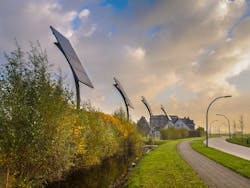New York is outstripping the nation in development of community distributed generation, and now it’s got a plan to more than double installations.
Also known as shared renewables, community solar or solar gardens, the approach creates communal local energy meant largely to benefit apartment dwellers, those with shady roofs or other obstructions to installing onsite renewables. Participants pay a portion of their energy bill toward the project’s power production.
With 800 MW in the pipeline — more community solar than all of the states installed last year — New York energy planners are shopping a proposal to stimulate another 1,000 MW.
The plan would tweak existing incentives within each utility service territory based on their success so far in stimulating development. Policymakers are trying to find the right balance that encourages projects without overburdening ratepayers.
So far the incentives — called market transition credits — have ranged from about 1.49 cents/kWh to 10.51 cents/kWh depending on the service territory, according to a staff white paper issued by the Department of Public Service (Case 15-E-0082).
The state would eventually like to create a uniform statewide credit. But for now the white paper proposes adjustments based on how well each territory is meeting pre-set goals.
Progress has been quick in the suburbs of New York City up into Albany — the service territories of Central Hudson and Orange & Rockland. But in New York City itself, where Consolidated Edison operates, development has been very limited despite a high credit, according to the white paper.
The state has been encouraging community distributed generation through incentives pegged to specific megawatt goals, or tranches, for each territory. The incentives ramp down as goals are met.
The new proposal would re-adjust the incentives and tranches. For example, the commission recommends boosting the credit for the slow New York City market to 14.35 cents/kWh to spur 128 MW of community distributed generation. Once that is met, the credit would drop to 10.54 cents/kWh for the next 206 MW and then 9.49 cents/kWh for 50 MW.
Different incentive for hottest markets
Meanwhile, the credit would be eliminated for the hottest markets — Central Hudson and Orange and Rockland. However, the white paper cautions against withdrawing all support out of concern that the market will falter. Instead, it calls for another kind of incentive, not funded directly through utility rates, but from an existing pool of money from the New York State Energy & Research and Development Authority. The authority would pay the new incentives — 2.5 and 3 cents/kWh — directly to the project developers with the goal of adding an additional 50 MW of projects for Central Hudson and 45 MW of projects for Orange and Rockland.
The white paper was one of two issued late last week by the commission’s staff. The other paper focuses on the predictability and bankability of compensation related to the distribution value of energy technologies.
“Distributed energy resources, such as CDG, are critical to building out an energy system that will meet half of New York’s electricity needs with clean and renewable energy by 2030,” said John Rhodes, DPS CEO. “Smarter, forward-thinking compensation for these projects will assure that these markets are developed in a robust, cost-effective and sustainable way.”
The New York PSC staff requests comments on the community distributed generation proposal by October 15.
What’s your take on New York’s community distributed generation plan? Post your comments below or on our LinkedIn Group, Distributed Energy Resources.







